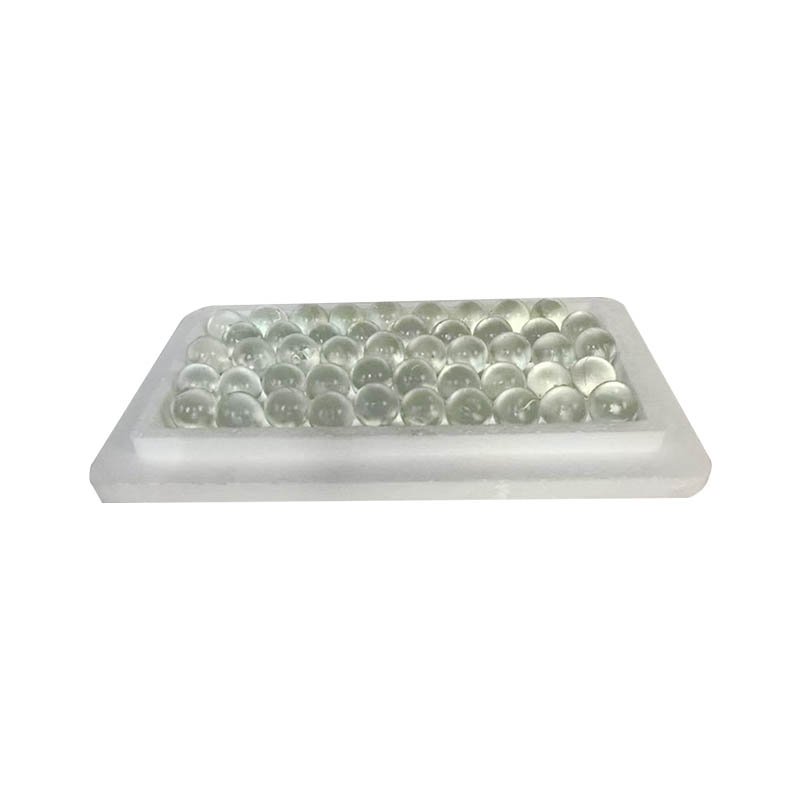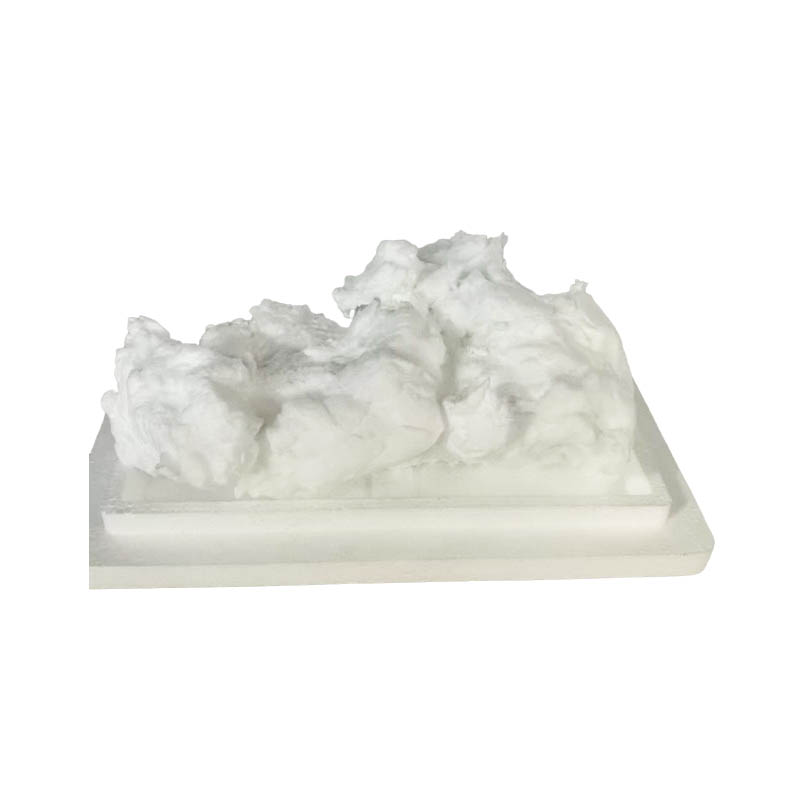How do glass balls empower the manufacturing of high-efficiency air filter materials?
Release Time : 2025-11-13
In the high-end air filtration field, glass microfiber filter paper, due to its ultra-fine fiber structure, high porosity, high temperature resistance, and chemical stability, is widely used in high-efficiency/ultra-high-efficiency air filters (HEPA/ULPA), automotive cabin air filters, industrial dust removal systems, and biosafety equipment. The source of all these high-performance filter materials is the specialty glass balls used in the melt-drawing process. These seemingly ordinary transparent particles are actually high-purity silicate materials with precise proportions and strict control. Their compositional uniformity, melting stability, and impurity control level directly determine the diameter consistency, mechanical strength, and filtration efficiency of the glass microfibers, serving as the "genetic carrier" of air filter paper quality.
The core superiority of specialty glass balls is primarily reflected in their ultra-high purity and precise chemical composition. The main components are silicon dioxide (SiO₂), aluminum oxide (Al₂O₃), calcium oxide (CaO), and a small amount of flux. All raw materials are selected from electronic or optical grade minerals, and the content of transition metal impurities such as iron, chromium, and nickel is controlled below 10 ppm, with the proportion of alkali metal oxides precisely controlled. This high-purity, low-iron formula not only ensures excellent clarity and fluidity of the molten glass but also gives the final drawn microfibers high resistivity, low coefficient of thermal expansion, and excellent corrosion resistance, making them suitable for cleanrooms, nuclear power plants, medical facilities, and other applications requiring extremely high material purity.
Stable melting performance is key to ensuring continuous production. Special glass balls are produced using a fully automated batching, high-temperature furnace melting, and water quenching process. The particle size is typically controlled between 3–8 mm, resulting in high sphericity, no bubbles, and no stones. These homogenized particles are heated evenly in electric furnaces or flame-blowing equipment, with a consistent melting rate, greatly reducing breakage, uneven particle size, or the formation of "slag balls" during the drawing process. Stable melt viscosity and surface tension allow for precise control of fiber diameter within the 0.2–2.0 micrometer range, forming a three-dimensional network structure that achieves a retention efficiency of over 99.97% for 0.3-micrometer particles (compliant with HEPA H13 standards).
Environmental and sustainability advantages are increasingly prominent. Compared to traditional organic fiber filter media (such as polypropylene), glass microfibers are non-flammable, non-aging, and can be used for a long time. Waste filter paper can be recycled and melted back into new spheres after high-temperature treatment, achieving a closed-loop cycle. Furthermore, modern glass ball production widely utilizes clean energy and waste heat recovery systems, continuously reducing unit energy consumption and resulting in a significantly lower carbon footprint than most synthetic material precursors.
Application adaptability is broad and customizable. By adjusting the glass composition, specialized glass balls suitable for different temperature environments (-50℃ to 500℃), humidity conditions, or chemical media can be produced. For example, a high-borosilicate system improves thermal shock resistance for automotive exhaust filtration; a low-alkali formulation enhances electrical insulation, making it suitable for cleanroom systems in electronics factories. This material-level flexibility allows filter manufacturers to develop differentiated products tailored to end-user needs.
Ultimately, the value of specialty glass balls lies not only in their "melt-fiber" formation but also in their atomic-level purity and molecular-level controllability, which forms the first line of defense for human respiratory safety. When hospital operating room air is efficiently purified, and when new energy vehicle battery packs are assembled in clean environments, it is all thanks to the nanoscale protective network fostered by these tiny glass balls. In today's world, where air quality and health protection are increasingly valued, high-quality specialty glass balls are silently and steadily driving global filtration technology towards higher efficiency, longer lifespan, and greener manufacturing.
The core superiority of specialty glass balls is primarily reflected in their ultra-high purity and precise chemical composition. The main components are silicon dioxide (SiO₂), aluminum oxide (Al₂O₃), calcium oxide (CaO), and a small amount of flux. All raw materials are selected from electronic or optical grade minerals, and the content of transition metal impurities such as iron, chromium, and nickel is controlled below 10 ppm, with the proportion of alkali metal oxides precisely controlled. This high-purity, low-iron formula not only ensures excellent clarity and fluidity of the molten glass but also gives the final drawn microfibers high resistivity, low coefficient of thermal expansion, and excellent corrosion resistance, making them suitable for cleanrooms, nuclear power plants, medical facilities, and other applications requiring extremely high material purity.
Stable melting performance is key to ensuring continuous production. Special glass balls are produced using a fully automated batching, high-temperature furnace melting, and water quenching process. The particle size is typically controlled between 3–8 mm, resulting in high sphericity, no bubbles, and no stones. These homogenized particles are heated evenly in electric furnaces or flame-blowing equipment, with a consistent melting rate, greatly reducing breakage, uneven particle size, or the formation of "slag balls" during the drawing process. Stable melt viscosity and surface tension allow for precise control of fiber diameter within the 0.2–2.0 micrometer range, forming a three-dimensional network structure that achieves a retention efficiency of over 99.97% for 0.3-micrometer particles (compliant with HEPA H13 standards).
Environmental and sustainability advantages are increasingly prominent. Compared to traditional organic fiber filter media (such as polypropylene), glass microfibers are non-flammable, non-aging, and can be used for a long time. Waste filter paper can be recycled and melted back into new spheres after high-temperature treatment, achieving a closed-loop cycle. Furthermore, modern glass ball production widely utilizes clean energy and waste heat recovery systems, continuously reducing unit energy consumption and resulting in a significantly lower carbon footprint than most synthetic material precursors.
Application adaptability is broad and customizable. By adjusting the glass composition, specialized glass balls suitable for different temperature environments (-50℃ to 500℃), humidity conditions, or chemical media can be produced. For example, a high-borosilicate system improves thermal shock resistance for automotive exhaust filtration; a low-alkali formulation enhances electrical insulation, making it suitable for cleanroom systems in electronics factories. This material-level flexibility allows filter manufacturers to develop differentiated products tailored to end-user needs.
Ultimately, the value of specialty glass balls lies not only in their "melt-fiber" formation but also in their atomic-level purity and molecular-level controllability, which forms the first line of defense for human respiratory safety. When hospital operating room air is efficiently purified, and when new energy vehicle battery packs are assembled in clean environments, it is all thanks to the nanoscale protective network fostered by these tiny glass balls. In today's world, where air quality and health protection are increasingly valued, high-quality specialty glass balls are silently and steadily driving global filtration technology towards higher efficiency, longer lifespan, and greener manufacturing.






